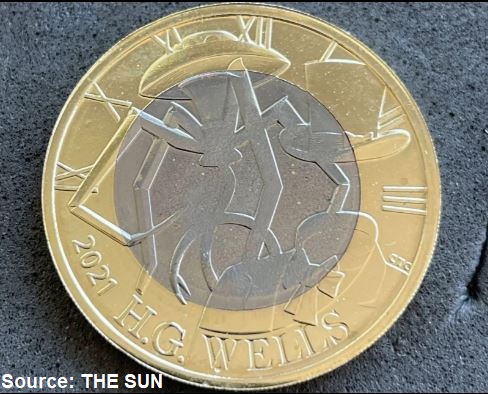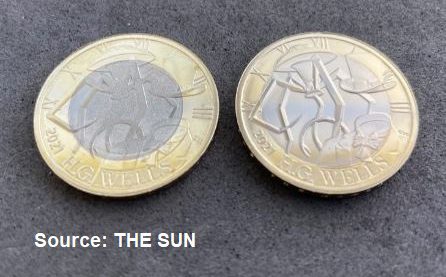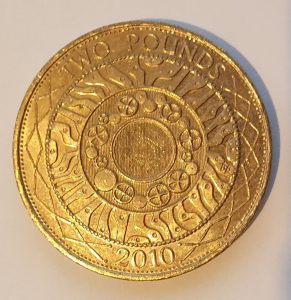Posts Tagged ‘coin errors’
Does your Paddington at the Palace 50p have the rare ‘crisp packet’ error?
It’s always exciting when a new coin ‘error’ or ‘mis strike’ is discovered, and I’ve just come across one I haven’t seen before – the Paddington at the Palace 50p ‘crisp packet’ error.

Paddington on UK Coins
Paddington Bear first appeared on UK coins in 2018, when 2 new 50ps were issued to celebrate 60 years since the beloved bear’s appearance in Michael Bond’s classic childhood tale. The first coin featured Paddington at his namesake train station, followed by him waving a flag in front of Buckingham Palace.

He continued his adventures around London in 2019 when a further 2 50ps were issued, showing Paddington in front of the Tower of London and St Paul’s Cathedral.

‘Crisp Packet’ Error
In the bottom left of the 2018 Paddington at the Palace 50p is a path in front of the Palace railings, just above the initials ‘DK’ for designer David Knapton.

Image Credit: @coinpatrol on YouTube
In the normal version of the coin (pictured above) a few solid lines and a dotted line appear on the path, however coins with the ‘crisp packet’ error show a small bubble underneath the left-most line.

Image Credit: @coinpatrol on YouTube
The ‘crisp packet error’, named so due to its resemblance to a crumpled up crisp packet, is thought to be due to a cracked die causing the metal to pool. The particular example pictured above was shared by Coin Patrol on YouTube and is suspected to have been struck toward the start of the minting process using the cracked die, however several other collectors have reported the error at different stages of die deterioration.

Image credits: josne-4158 on eBay, redelvis0077 on PicClick, @coinpatrol on YouTube
It’s not known how many Paddington at the Palace 50ps have this ‘error’, however if you have one in your collection, it could make the coin much more sought-after.
Not the first cracked die error
The 2015 First World War Navy £2 made waves when collectors started to notice that some versions of the coin looked to have a flying flag atop the mast of the ship.

A number of people wondered whether there were two different designs of the Navy £2, however it was later confirmed that the extra ‘flag’ was caused by a cracked die during minting.

Image credit: @coinpatrol on YouTube
Do you have any error coins in your collection?
If you’re lucky enough to have an error coin or mis strike in your collection, let us know in the comments!
You can check out our Myths and Mis strikes blog for more information on common ones to look out for.
Add the Paddington at the Palace 50p to your collection
Secure the 2018 Paddington at the Palace 50p in Brilliant Uncirculated quality >>
Is your H.G. Wells £2 coin worth thousands? How to spot if you’ve got an ‘error’ coin!
Every keen collector knows that it is worthwhile paying close attention to the small details of your coins – it’s the only way you can ever hope to spot an error.
From edge inscription mix ups to inverted effigies, there are a few stories that crop up more often than not. However, recently, a couple of ‘error’ stories have cropped up, that Change Checker really think you should pay attention to – involving an H.G. Wells £2 and the Technology £2…
Stay tuned as we take a closer look at these ‘errors’ and help you determine if your £2 coin is a genuine rarity!
H.G. Wells £2 – Blank ‘Error’

This £2 coin was issued as part of the 2021 UK Commemorative Coin set and it marks the 75th anniversary of the death of science fiction novelist, H. G. Wells.
With the clue in the name, this bi-metallic coin is made up of a combination of a silver coloured cupro-nickel disc and an outer yellow nickel-brass ring.
In the case of this H.G. Wells £2 coin however, it appears that the blank used has a thicker yellow ring, much wider than what we’d see on normal £2 coins.

When striking £2 coins, the first step is to punch a hole through a blank planchet to create the outer section. The inner core is taken from a different metal, sized to fit inside the outer ring.
There have already been estimations that if this coin was to be sold at auction, it could fetch over £1,000! We’re going to be eagerly awaiting confirmation from The Royal Mint whether this error is genuine or not. Nonetheless, it certainly makes for interesting collecting!
This coin is yet to be individually issued, so any ‘error’ versions will have come exclusively from the 2021 UK Annual Set. It’ll certainly be interesting to see if any other stories crop up after the coin’s individual issue….
Whilst there are no identical examples to compare the H.G. Wells £2 ‘error’ to, there have been previous instances of the inner and outer sections of £2 coins not quite matching up:
Clipped Planchet

In the above image, the inner core was punched out from the end of the sheet of metal used for blanks, forming a straight or ragged edge clip.
Whilst this also occurs with monometallic coins, the pairing with an outer ring exposes a large gap which is much more noticeable.
The Royal Mint strike millions of coins each year so it is inevitable that variances will occur during the striking process and can’t always be picked up during quality control, despite the fact that this particular coin would weigh less than the standard 12g £2 coin.
Off Centre Inner Core

The inner core of this coin hasn’t been united properly prior to being struck, resulting in an off centre inner core.
Due to the way the inner and outer core are struck together with the two metals being lined up and then fused together during striking, a misalignment will mean that the inner core spills into the outer ring, as seen in the image above. There might also be a gap between the two metals on the opposing join.
Faulty Outer Ring

This particular mis-strike, shows a faulty planchet or outer ring, where the inner core is exposed.
In the image above, you can actually see the specific engineering design features where the inner core is grooved to help the metal flow bond to the outer ring and fuse during striking.
Similar to the first mis-strike we looked at, this could be caused by a clipped planchet, this time created when the outer ring was punched, however coins like this may also be caused by tampering post striking, for example by fakers trying to replace the inner core of a £2 with another coin to pass off as a rare error.
Bronze £2 Error

The ‘Monometallic’ £2 is described as the Holy Grail of bimetallic ‘errors’ and is the result of the nickel-brass £2 blank not having the inner core section punched out before being struck.
This means that the £2 coin is made from one full piece of nickel-brass, completely contrasting the very idea of a bimetallic coin.
A 2007 monometallic £2 was verified by The Royal Mint and in the email confirming the mis-strike it was mentioned that they had only seen 4-5 similar coins before.
However, in 2021, Change Checker was contacted by a collector called Amin who informed us that he had found this exact error coin but with a 2010 date.
After sending details of his coin to The Royal Mint for further information, it was confirmed to be genuine error as a result of the minting process.

This rare striking error is highly sought-after and coins have achieved extraordinary prices in private sales and auctions.
Whilst information of this coin’s sale has remained private, it’s certainly a very interesting story and we imagine the collector can expect to see a very impressive return on this coin…
We look forward to the individual release of the HG Wells £2 later this year and will certainly be keeping our eyes peeled for any unusual looking variations!
Have you ever come across any of these £2 error coins in your collection?
We’d love to know! Comment below.
Secure the 2021 UK Commemorative Coin Set – featuring the H. G. Wells £2!
How much is my Charles Dickens £2 worth?
Every keen collector knows that it’s worthwhile paying close attention to the small details of your coins – it’s the only way you can ever hope to spot an error. However, it’s also important to know when you have a genuine rarity (and when you don’t).
There are a few stories that crop up more often than others, and one of them is the elaborated value of the Charles Dickens £2. So hopefully this post will help dispel some of the myths about the coin.
Could your Charles Dickens £2 be worth a fortune?
The Charles Dickens £2 coin was issued by The Royal Mint in 2012 to commemorate the 200th anniversary of one of Britain’s most famous and beloved writers. The design features Dickens’ recognisable profile crafted from the titles of his most famous works, and it’s a favourite amongst collectors.
But occasionally, a number of stories pop up regarding the ‘errors’ people have noticed, such as fading dots around the centre part, upside down edge lettering and misspelling of the edge inscription. In fact, some of these coins have even been listed on eBay for thousands of pounds, leaving Change Checkers wondering “how much is the Charles Dickens’ £2 coin actually worth?”

But before you get too excited and consider putting your Charles Dickens up for sale, let’s take a look at what these ‘errors’ really mean…
Disappearing dots
This has also been found on many other £2 coins so is not exclusive to the Dickens coin, where the dots that should that go all around the silver centre of the coin suddenly disappear. Unfortunately this wouldn’t actually add any value to the coin, as it is simply caused by the mass production process, where millions of coins are being struck at once and the dies get worn down.
It’s difficult to ensure all coins are produced exactly the same, considering that millions are struck at one time, but we definitely feel that variations like this make collecting even more exciting!

Upside down lettering
Upside down lettering is very common on bi-metallic coins and can be seen on many of the £2 coins you can find in your change. Again, this isn’t actually an error, but a variation to look out for on your coins. It happens during the minting process, when the edge lettering is applied before the obverse and reverse of the coin have even been struck.
This then explains why some coins can end up with the edge lettering appearing upside down.

Misspelled edge inscription
Many people have noticed that there is a ‘miss spelled’ WILL on the edge inscription of their Charles Dickens £2 coin. This is actually caused by a worn out die, where the end of the L has been worn down to look like an I.
This is a common variation amongst coins and can also be seen on the 2005 Gunpowder plot £2, which now has many variations of edge inscription due to the worn out R appearing as a P.

So how much is it actually worth?
The Charles Dickens £2 coin actually ranks as ‘common’ on our Scarcity Index, meaning it’s not considered a rare coin, however it is interesting to hear about the different variations people have noticed on their coins and looking out for these makes for great coin collecting!
Unfortunately, people listing coins like this on eBay hoping for extortionate amounts are usually just chancers looking for a quick buck and it’s rare that the coin has an actual error.
It’s the differences caused by human error, such as a wrong date or design or even the wrong metal used that are a lot more sought after and would likely have added value for your coin – so be sure to keep a look out for these!
You can use our 6 point guide to valuing your coins to work out how much your coins could actually be worth.
You can also check out our eBay Tracker to see what the top rarest coins and banknotes are selling for on the secondary market.




